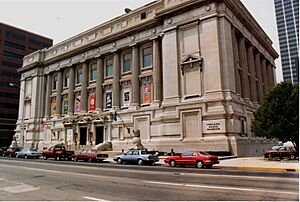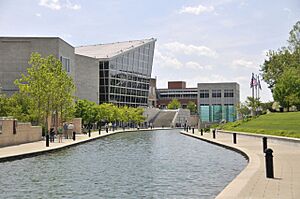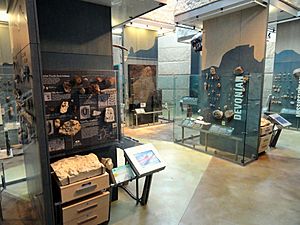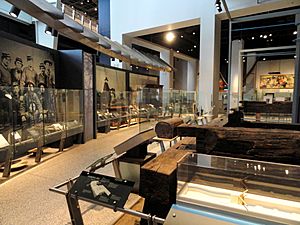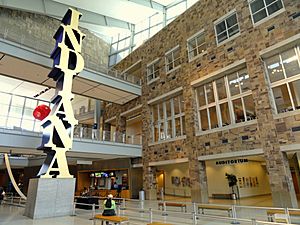Indiana State Museum facts for kids
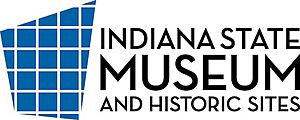 |
|

The Indiana State Museum in 2020
|
|
| Lua error in Module:Location_map at line 420: attempt to index field 'wikibase' (a nil value). | |
| Established | 1869 |
|---|---|
| Location | White River State Park, Indianapolis, Indiana, U.S. |
| Type | History museum |
| Architect | RATIO Design |
| Owner | State of Indiana |
| Public transit access | |
The Indiana State Museum is a large museum in downtown Indianapolis, Indiana. It's a place where you can explore the science, art, culture, and history of Indiana. The exhibits cover everything from ancient prehistoric times to today.
Contents
The Museum's Long Journey
The museum's story began in 1862 with a small collection of interesting objects. A man named R. Deloss Brown, who was the State Librarian, started gathering them. By 1869, the state government decided to create an official collection to show off Indiana's natural history, like its rocks and minerals.
Over time, more items were added. People donated things related to the Civil War and other parts of Indiana's culture. This small collection was the beginning of the museum we know today.
A Home in the Statehouse
For many years, the museum's collection was kept on the third floor of the Indiana Statehouse. But in 1919, it had to move to the basement to make space for another government department.
Down in the basement, the collection was not well cared for. For nearly 45 years, many items were lost or damaged because they weren't protected. The museum even had to close down twice because of these problems. By the 1950s, it was clear that the museum needed a new, better home to protect Indiana's treasures.
Moving to the Old City Hall
In the early 1960s, a new location was found: the old Indianapolis City Hall building. The building, which was built in 1910, was no longer being used by the city. After some renovations, the Indiana State Museum opened in its new home in 1967.
This new location was a big success! More people started visiting, and many donated important artifacts. The museum's collection grew so much that by the late 1970s, it was running out of space again. It was time to find an even bigger home.
A New Building in White River State Park
In 1979, the state decided to create White River State Park. The planners thought a new state museum would be a perfect fit for the park. In 1995, plans were made to build an IMAX theater first, with the museum to be built around it later. The IMAX theater opened in 1996.
Finally, in 1999, construction began on the new museum building. It was designed by a local company called Ratio Architects. The brand-new Indiana State Museum opened on May 22, 2002. Hundreds of schoolchildren from all over Indiana came to celebrate the grand opening.
Exploring the Museum's Galleries
The museum has three floors of exhibits that tell the story of Indiana. The galleries are designed to take you on a journey through time as you move up through the building.
First Floor: Indiana's Natural World
The first floor is all about Indiana's natural history, from ancient times to today.
- Ancient Seas: See what Indiana looked like when it was covered by a shallow ocean.
- Frozen Reign: Discover the Ice Age and the giant animals that once roamed the land, like mammoths and mastodons.
- First Nations: Learn about the lives and cultures of the Native American people who first lived in Indiana.
- Natural Regions: Explore Indiana's diverse landscapes, from its dunes and wetlands to its forests and prairies.
Second Floor: Indiana's People and Progress
The second floor tells the story of the people who built Indiana and the state's growth.
- 19th State: Find out how Indiana became the 19th state in the United States.
- The Hoosier Way: Explore what makes Indiana unique, from its traditions to its famous people.
- Crossroads of America: Learn how canals, railroads, and highways shaped Indiana's history and connected it to the rest of the country.
- Enterprise Indiana: See the products and inventions that came from Indiana, from cars to medicines.
Third Floor: Indiana's Art and Culture
The third floor is dedicated to art and special exhibitions. The galleries here change regularly, so there is always something new to see. It features paintings, sculptures, and other works by talented Indiana artists.
Special Features
- 92 County Walk: Outside the museum, you can see a unique sculpture for each of Indiana's 92 counties. Each piece of art represents what makes that county special.
- L. S. Ayres Tea Room: Step back in time in this recreation of a famous tea room that was once in a downtown Indianapolis department store. It uses original furniture and decorations to make you feel like you're in the early 1900s.
The Museum's Collections
The museum has a huge collection of over 500,000 objects! These items are related to Indiana's history, art, and natural science. The collection focuses on six main areas:
- Ice Age fossils and bones
- Items related to President Abraham Lincoln, who spent part of his childhood in Indiana
- Art created by Indiana artists
- Quilts and other handmade textiles
- Objects from Indiana's farms and factories
- Artifacts from ancient Native American sites
The museum also takes care of the official portraits of nearly all of Indiana's governors. Most of these paintings hang in the Indiana Statehouse.
Indiana's State Historic Sites
The Indiana State Museum is part of a larger group that also manages 11 other historic sites around the state. These sites protect important places in Indiana's history.
| Site name | Image | Nearest city | County | Description |
|---|---|---|---|---|
| Angel Mounds State Historic Site | 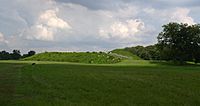 |
Evansville | Vanderburgh and Warrick | An ancient Native American town with large earthen mounds, built by people of the Mississippian culture between 1000 and 1450. |
| Corydon Capitol State Historic Site | 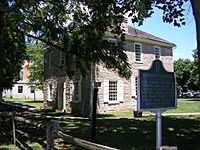 |
Corydon | Harrison | This site includes Indiana's first state capitol building and other historic government buildings from when Corydon was the state capital. |
| Culbertson Mansion State Historic Site | 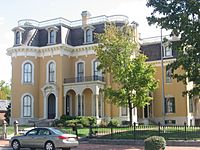 |
New Albany | Floyd | A grand 25-room mansion built in 1867 by a wealthy businessman named William S. Culbertson. |
| Gene Stratton-Porter State Historic Site | 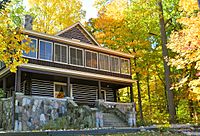 |
Rome City | Noble | The home of famous author and nature lover Gene Stratton-Porter, where she lived from 1914 to 1919. |
| Lanier Mansion State Historic Site |  |
Madison | Jefferson | A beautiful home built in 1844 for J.F.D. Lanier, an important banker. It sits right on the Ohio River. |
| Levi & Catharine Coffin State Historic Site | 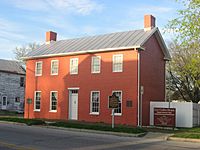 |
Fountain City | Wayne | The home of Catharine and Levi Coffin, who helped many enslaved people escape to freedom. Their home was known as the "Grand Central Station of the Underground Railroad." |
| Limberlost State Historic Site |  |
Geneva | Adams | The log cabin home of author Gene Stratton-Porter, built in 1895. It was named after the nearby Limberlost Swamp, which inspired many of her books. |
| New Harmony State Historic Site | 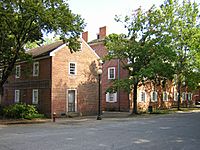 |
New Harmony | Posey | A historic town first settled by a religious group called the Harmony Society. It later became a center for science and education. |
| T. C. Steele State Historic Site | 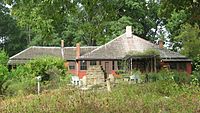 |
Nashville | Brown | The beautiful home and art studio of famous Indiana artist Theodore Clement Steele. |
| Vincennes State Historic Sites | 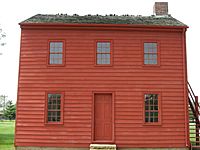 |
Vincennes | Knox | Vincennes is Indiana's oldest city and was its first capital. This site includes important early buildings like the Indiana Territorial Capitol. |
| Whitewater Canal State Historic Site | 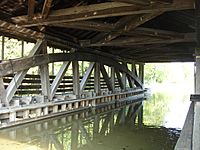 |
Metamora | Franklin | A section of a 76-mile canal. This site has the Duck Creek Aqueduct, the last working wooden aqueduct in the United States. |
See also
- List of U.S. state historical societies and museums
- List of attractions and events in Indianapolis
- Indiana Register of Historic Sites and Structures
- Indiana Steam Clock


